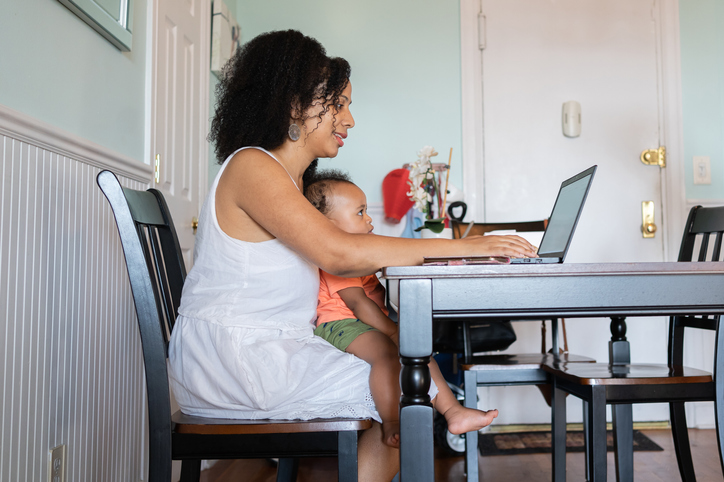How Work-From-Home Culture Has Amplified Inequalities
Share the post
Share this link via
Or copy link

Source: valentinrussanov / Getty
Thirty percent of executives predict the need for less brick-and-mortar workspace moving forward, due to the COVID-19 pandemic and the rise of the work-from-home employee. As of April 2020, at least 20 percent of individuals were working from home, according to one poll. A surprising four percent are able to work from home but choose not to. That could be because some people want the in-person engagement of working in an office, But then there are those who simply cannot work from home in order to do their jobs and are going to a physical space to work, whether they want to or not.
The work situations of Americans right now are certainly varied and shifting. Along with the many other unforeseen consequences of the pandemic is the fact that remote-working is amplifying other issues. A butterfly effect was set into place when many jobs had to move to remote locations, and when other jobs were simply eliminated because of COVID-19. Trends and patterns that were already taking place in the workforce became accelerated, and one of those is inequality: financial, racial, educational, and gender inequality. Think of the resources and equipment required for a work-from-home job. Think of the types of jobs that offer this option, and the ones for which it’s impossible. The gap between certain groups is growing rapidly now. Here’s why.

Source: Viorel Kurnosov / EyeEm / Getty
High-paid jobs were already distanced
When we take a look at who is able to work from home we see that it’s those who were already making large salaries. The high-paid jobs were already distanced. Executive-level positions rarely need to be done at any specific location. Most professions that can easily be done remotely or virtually are professions that pay better than those that must be done in-person. That means the already-rich are the ones keeping their jobs.

Source: Dean Mitchell / Getty
High-paid jobs go to the college-educated
The same chart that showed most remote workers were already receiving high salaries showed one other type of employee who can work remotely: the college-educated. Those with a college degree tend to have occupations that can be done remotely more than those who do not. So what of individuals who can’t afford a college degree? Or those who didn’t graduate high school, and are ineligible to apply to college? A racial and geographical divide already existed among these groups.

Source: JGI/Jamie Grill / Getty
Parents who can’t afford childcare
What about two-parent households with both parents working from home? One study finds that while fathers working from home are increasing parenting duties during this time, moms are still taking on the brunt of the work. Working moms are already under the scrutiny of having to balance it all. Now those who can’t afford childcare, and are perhaps even homeschooling, are balancing even more.

Source: Michele Pevide / Getty
Women are skipping work
As for women who have jobs that require them to go into a brick-and-mortar location, the pandemic is particularly tough. Research has found that they are more likely than their male counterparts to take days off work or pass up on shifts in order to stay home with the kids. That won’t bode well for the already existing gender income gap.

Source: Vladimir Vladimirov / Getty
Primarily women do these in-person jobs
Women make up the majority of the workforce in many jobs that require employees to go into work. Over 83 percent of maids and housekeepers are women. Over 70 percent of food servers are women. Over 92 percent of childcare workers are women. These are jobs that simply cannot be done remotely, meaning they’re taking a hit, meaning the female workforce at large is suffering.

Source: Nazar Abbas Photography / Getty
Limited access to equipment
Working from home often requires having a laptop. In some cases, it requires two computers depending on the depth of the projects. Video editors or streamers, for example, tend to work on two computers at once. Many employees who have been sent home to work relied on access to office equipment to do their jobs. Others who are looking for new remote jobs may not have the equipment required. And they may not have the money to buy it.

Source: Grace Cary / Getty
Limited access to software
Software can also be expensive. Yet it’s normal to see in a job ad that “Excel,” “Photoshop,” or “Final Draft” is required for a job. These programs can be hundreds of dollars. Individuals who cannot afford to purchase that software may find their job options are limited. Sometimes, one must take a class to learn how to use the software, and that class alone costs money. Already-employed individuals may find their company will pay for these classes, for them. But what about the unemployed job-seekers? They must fund these classes themselves.

Source: Tempura / Getty
These low-paying jobs are losing work
Hospitality, retail, and education saw some of the greatest job losses during this pandemic. Those also typically encompass low-paying jobs like teachers, food servers, bartenders, housekeepers, and shop associates. Individuals who were already in a difficult position to put away emergency funds were also the ones most likely to lose their paychecks.

Source: SDI Productions / Getty
Some don’t have space
Working from home can be difficult for those living with others in small spaces. Research has found that employees find remote collaboration more mentally draining than in-person meetings. That’s true regardless of the size of the home office. Research has also found that it’s easy for physical and psychological boundaries to become blurred when working from home, something amplified for those in small spaces, that puts their quality of work at risk.

Source: FG Trade / Getty
Ethnicity and occupation trends
A significant discrepancy exists between races and ethnicities, and which groups are more or less likely to be able to work from home. Non-white individuals are more likely to have jobs that require them to go to work in person. That also means those groups work the jobs that are most likely to see layoffs during a pandemic.

Source: SDI Productions / Getty
The risk of getting sick
Essential workers are more likely to get sick or die than people who can stay home right now. COVID-19 can leave some workers bedridden or, worse, in the hospital for weeks and sometimes months at a time. If those are essential workers, that means they’re unable to go into the jobs that already paid very little. Those most likely to miss work because of illness are the same workers who can least afford to do so.

Source: adamkaz / Getty
What about the gig economy?
Statistics say 55 million Americans rely on the gig economy for their income. But the gig economy is typically missing one major thing: benefits, like healthcare. The gig economy also consists of jobs that require in-person tasks like food delivery, rideshare driving, and handyman work. Gig economy workers, like essential workers, often must leave their homes to work, putting themselves at risk of illness, and don’t have health insurance.

Source: FG Trade / Getty
Part-time workers are the first to go
Part-time workers naturally make less money than their full-time peers. Part-time employees are also the first to go during layoffs and furloughs. They’re also the last to be re-hired when companies are made whole again. Those who already needed more work before the pandemic were more likely to lose the little work that they had during it.

Source: eyecrave / Getty
No time for higher education
It’s been established that remote-working jobs tend to be the higher-paying ones, and the higher-paying ones tend to require higher education. Online classes to advance one’s education require two things: free time and, sometimes, disposable income. The groups who have neither of those are at a disadvantage when it comes to furthering their careers. Disposable income and free time may have decreased, with COVID-19 causing job loss, and turning parents into homeschool teachers.

Source: Tashi-Delek / Getty
Women are being interrupted
While video conferencing can be a great tool, it’s bringing to light gender inequality issues in communication. Women already struggled to be heard in the physical workplace. Research is showing that, with the additional divides of space and computer screens, women are being spoken over and interrupted even more on Zoom calls.
-

She Tried It: Ivy Park Drip 2 and 2.2 Black Pack
-

Vontélle Eyewear Founders Score History-Making Licensing Deal With Paramount
-

She Tried It: Inahsi Naturals Aloe Hibiscus Leave-In Conditioner & Detangler
-

'Can't Walk While Black' — Pregnant Woman Ticketed For Walking On ‘Wrong Side’ Of The Road — But Her White Husband Wasn’t









